By Redeye Ropertz
SCORESOctober 25 Honolulu November 23 Nagoya Hawaiian All Stars 1 Nippon All Stars 2 All Americans 8 All Americans 6
November 03 Tokyo November 24 Osaka All Americans 17 Nippon All Stars 3 Nippon All Stars 1 All Americans 15
November 04 Tokyo November 25 Osaka Nippon All Stars 1 Miller's Team 5 All Americans 5 Ruth's Team 1
November 08 Hakodate November 26 Kokuru Nippon All Stars 2 Nippon All Stars 1 All Americans 5 All Americans 8
November 09 Sendai November 28 Kyoto Nippon All Stars 0 Nippon All Stars 1 All Americans 7 All Americans 14
November 10 Tokyo November 29 Omiya Nippon All Stars 0 Nippon All Stars 5 All Americans 10 All Americans 23
November 11 Tokyo December 01 Utsunomiya Ruth's Team 13 Nippon All Stars 5 Miller's Team 2 All Americans 14
November 13 Toyama December 05 Shanghai Nippon All Stars 0 Shanghai All Stars 1 All Americans 14 All Americans 22
November 17 Tokyo December 09 Manila Nippon All stars 6 American All Stars 13 All Americans 15 Manila Bay Leaguers 1
November 18 Yokohama December 09 Manila) Nippon All Stars 4 American All Stars 7 All Americans 21 Manila Bay Leaguers 3
November 20 Shizuoka December 10 Manila Nippon All Stars 0 All-Americans 9 All Americans 1 Philippine Olympic National Team 1
November 22 Nagoya
Nippon All Stars 5
All Americans 6
American All-Stars All-Nippon
Morris Berg C Washington Senators Jiro Kuji C, #15 Frank Hayes C Philadelphia Athletics Toshiharu Inokawa C, #25 George(Babe) Ruth 1B/OF New York Yankees Minoru Yamashita 1B, #20 Charlie Gehringer 2B Detroit Tigers Osamu Mihara 2B, #2 Jimmie Foxx 3B Philadelphia Athletics Shigeru Mizuhara 3B, #4 Harold Warstler 3B Philadelphia Athletics Hisanori Karita SS, #1 Eric McNair SS Philadelphia Athletics Haruyasu Nakajima OF, # Lou Gehrig LF/1B New York Yankees Mamoru Sugitaya OF, #24 Earl Averill CF Cleveland Indians Jimmy Horio OF, #6 Bing Miller RF Philadelphia Athletics Kumeyasu Yajima OF, #7 Isamu Fuma OF, #28
Hisashi Asakura IF, # Motonobu Makino IF, #26 Fujio Nagasawa IF, #14 Usaburo Shintomi IF, #
Tokio Tominaga IF, #30 Ri(Lee) Eibin UT, #5 Pitchers
Vernon(Lefty) Gomez LHP New York Yankees Kenichi Aoshiba P, #9 Clint Brown RHP Cleveland Indians Masao Date P, #18 Earl Whitehill LHP Washington Senators Shinji Hamazaki P, #22 Joe Cascarella RHP Philadelphia Athletics Saburo Miyatake P, # Eiji Sawamura P, #8 Victor Starffin P, #31
Tokio Takahashi P, # Kaichi Takeda P, #21
Connie Mack MGR Philadelphia Athletics Daisuke Miyake MGR
TYPICAL STARTING LINE-UP AMERICAN LEAGUE ALL-STARS ALL NIPPON
BA HR McNair SS .280 14 Makino 2B Gehringer 2B .356 11 Karita SS Ruth 1B .288 17 Mihara 3B Gehrig LF .345 49 Horio CF Foxx 3B .334 44 Yajima RF Averill CF .313 31 Yamashita 1B Miller RF .243 01 Fuma LF
Berg C .244 00 Inokawa C Gomez P N/A N/A Date P
GAME REPORTS
En route to Japan, the American League All Stars stopped over at Honolulu to play an exhibition game with the Hawaiian All Stars.
October 25, 1934
Honolulu, Hawaii
National Stadium
Attendance: 25,000
R H E
Hawaiian All Stars 1 6 5
All Americans 8 6 0
WP - Gomez LP - Kerr
HR – Gehrig
Hawaii had a long history of organized baseball dating back to the the turn of the century. Many of the teams were organized on ethnic background which reflected Hawaii's immigration evolution of diversity. There were the All-Chinese, the All-Hawaiians and the Asahi baseballers. Concomitantly, the Hawaiian All Stars would be the most diverse squad any of the American League players would ever face. The local contingent included mixed natives, Hawaiians, Chinese, Japanese, Portuguese, Caucasians, and a lone black American player, Ted Shaw. Honolulu Stadium, the site of the contest, was a magnificent venue for a baseball game. Majestically situated in the background behind the center field fence stood the volcano, Diamond Head.
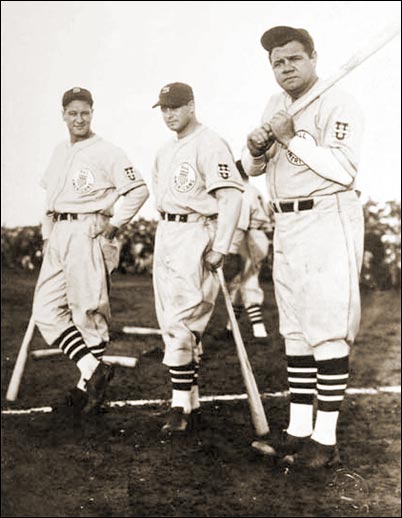 Given their power-laden line-up, the All Americans were expected to light up the scoreboard. During batting practice, they did not disappoint as Foxx, Averill, Gehrig and of course the Bambino sent ball after ball soaring over the outfield fences. Gehrig hit one that was estimated to have traveled 475 feet.
Given their power-laden line-up, the All Americans were expected to light up the scoreboard. During batting practice, they did not disappoint as Foxx, Averill, Gehrig and of course the Bambino sent ball after ball soaring over the outfield fences. Gehrig hit one that was estimated to have traveled 475 feet.
Despite this show of power, the game itself actually started off as a pitcher’s duel. Their timing in the batter’s box off because of inactivity, the rusty Major Leaguers were kept off balance with the offerings of starting chucker Johnny Kerr who allowed just one hit while striking out three during his early stint on the knoll. At the same time, 26-game winner Vernon "Lefty" Gomez of the New York Yankees had no difficulty in whiffing seven of the twelve batters he faced during his four frames of mound work. Things began to change in the bottom of the fifth, however. A Gehringer single, two walks and a pair of errors led to three unearned tallies by the All Americans, a development which clearly eroded the confidence level of the Hawaiians. The Americans added five more over the final five innings. Gehrig had the lone round-tripper. The “Iron Horse" clobbered one off the delivery of Ted Nobrigue, a half Portuguese and half Hawaiian, that landed on the roof of the grandstand area in center field used by spectators during football games. One can only imagine the scramble by souvenir-hunters fighting over these priceless baseballs. Ruth had a pair of doubles. In the eighth, he drove one to deep centre field, the ball hitting the fence on the first bounce and "Babe, like a portly old gentleman passing a contribution box in church, toddled down to second base. This blow delivered by a speed merchant would have blossomed into a four-sacker in any ball park." (Honolulu Advertiser).
November 03, 1934
Tokyo, Japan
Meiji Jingu Stadium
Attendance: 65,000
R H E
Nippon All Stars 1 6 3
All Americans 17 12 2
WP - Whitehill LP - Takahashi
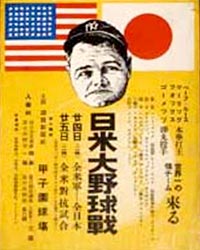 It would be safe to assert that no foreigner who stepped for the first time on Japanese soil had a bigger and more dramatic impact than Babe Ruth. When the team arrived in Yokohama on November 02, police reserves were called out to handle the throng of fans who turned out to greet them. In Tokyo, the crowds were even larger and more festive. The route travelled by the All Americans to their hotel was jammed with a crowd estimated to be in excess of 100,000. With confetti and streamers flowing down from buildings adjacent to the travel route, the welcoming Japanese roared in approval as the team drove by while the gregarious “Sultan of Swat” attempted to shake the hands of everyone within the horde of admirers.
It would be safe to assert that no foreigner who stepped for the first time on Japanese soil had a bigger and more dramatic impact than Babe Ruth. When the team arrived in Yokohama on November 02, police reserves were called out to handle the throng of fans who turned out to greet them. In Tokyo, the crowds were even larger and more festive. The route travelled by the All Americans to their hotel was jammed with a crowd estimated to be in excess of 100,000. With confetti and streamers flowing down from buildings adjacent to the travel route, the welcoming Japanese roared in approval as the team drove by while the gregarious “Sultan of Swat” attempted to shake the hands of everyone within the horde of admirers.
The Americans opened their 18-game tour of Japan with two contests in Tokyo. All games were held in the huge Meiji Jingu shrine capable of handling crowds in excess of 65,000. The stadium had been completed in 1926 and was home to the Big Six University League. The outfield walls stood 330 feet down the lines and center-field was 390 feet away. Reserve seats were sold out weeks in advance and ticket prices were triple the level usually charged in the United States. Incredibly, even larger crowds were expected when the Americans reached Osaka. The Koshien Stadium in that locale seated 80,000 and was capable of holding crowds of over 100,000. In 1930, upwards of 220,000 Japanese fans had attended the national Secondary School Baseball Championship of three games held at this venue. When the gates opened at 09:30 hours on November 03, the lines outside of Meiji Jingu Stadium had swollen into the thousands.
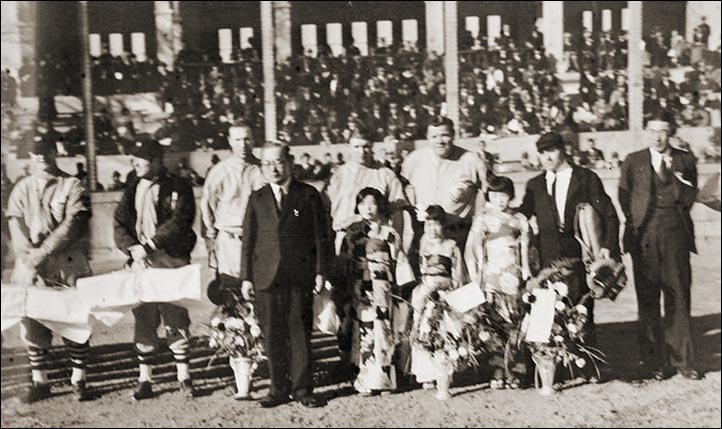
The opening ceremonies opened sharply at 12:10. First out of the tunnel was co-organizer of the series, Sotaro Suzuki, followed by Connie Mack in his ever-present tailor-made suit with starched collar. Mr. Mack knew a truth that most field managers try to evade, that being as one gets a bit portly one should avoid wearing a a ball uniform. Next came the God of Baseball, George Herman "Babe" Ruth. His arrival was greeted with a thunderous roar and chants of "Banzai Banzai Bee-Ruth.” The remaining members of the American League All Stars followed the Babe onto the diamond in their resplendent red jackets and striped hosiery. Last came the home team who physically looked a bit like children compared to the Americans
The All Nippon squad consisted of former players from the prestigious Tokyo Big Six University League. Their roster included the best and most popular popular ball players in the nation. The Japanese would unveil seventeen year old pitching phenom Eiji Sawamura. Also on the roster was Hawaiian born Jimmy Horio as well as Minoru Yamashita who led the Big Six in both batting and home runs. Soon to catch everybody's eye was slick-fielding Hisanori Karita. He would dazzle Western Canadian baseball fans the following year as a member of the touring Dai Nippon aggregation. There were no empty seats during batting practice and the Americans did not disappoint, belting drive after drive into the outfield stands. The Japanese fans waited eagerly for the actual tilt to start so they could watch the expected bombardment by the American sluggers.
As they did throughout the Japanese tour, the Americans allowed their hosts to bat first with the intent of having a sufficient lead so as not to require batting in the ninth inning and inflate the run differential. The story line of this game happened in the top of the first frame. Thirty-five year old Earl “The Earl” Whitehill opened this momentous series with a hard fastball intended to intimidate leadoff batter Katchi Masu. To the amazement of the jam-packed stadium, Masu delivered a clean single up the middle. The Japanese fans were electric with excitement but this celebration was short-lived as Masu was picked off by the cagey Whitehill at first. A ground out and a strikeout later, the inning was over and the difference in skill sets soon became obvious.
Tokio Takahashi had the daunting task of being the first Japanese pitcher to face the Americans’ awesome batting line-up. Jimmie Foxx alone had belted 150 home runs over the past three seasons. Takahashi was nervous and many of his deliveries were off target but he was lucky to escape the initial inning unharmed. He was not so fortunate thereafter. The visitors plated three runs in the second frame and followed that outburst with runs in every inning except the seventh on their way to a 17 - 1 shellacking. There were no home runs but this can be partially explained by the dimensions of the ball park and Takahashi's erratic pitching. Ruth and Gehrig, anxious to belt one out of this cavernous ball park, swung at many outside pitches.
November 04, 1934
Tokyo, Japan
Meiji Ginghu Stadium
Attendance: 65,000
R H E
All Nippon 1 3 2
All Americans 5 10 2
WP - Cascarella LP - Date
HR - Averill 2, Foxx and Gehrig
Once again, the 65,000 seats were filled for batting practice and, once again, the Americans put on an explosive demonstration of power hitting. In recognition of the slugging prowess of the tourists, manager Daisuke Miyake of the All Nippons chose his best chucker, Masao Date, to handle the pitching duties. Date had previously faced Major League hitters and was not intimidated by the prospect of challenging them. Although winless in the series, Date won the praise of none other than the “Iron Horse” himself, Lou Gehrig.
In the first inning, this strategy was effective and no runs were scored but matters changed in the second frame. With two out, Date walked Babe Ruth and on a two-strike count, Jimmy “the Beast” Foxx belted the first home run in the series. Earl Averill followed with another four-bagger and the All Americans led 3 - 0. Gehrig added a third home run in the next inning. Date then loaded the bases in the seventh canto but fanned opposing twirler, Joe Cascarella, to escape further damage. On the mound, Cascarella was more effective, limiting his opponents to three scattered hits. Averill was the overall star for the victors, going three for four, scoring two runs and playing flawless ball in the field. Although the Babe did not homer, he hit two drives that would have been home runs in virtually any ball park in America. The Japanese fans were eager to see home runs even if they were hit by the Yanks.
November 08, 1934
Hakodate, Japan
Attendance 8,000 (Capacity)
R H E
All Nippon 2 7 3
All Americans 5 6 1
WP - Gomez LP - Aoshiba
HR - Averill
The third game was slated for Hakodate on the northern Island of Hokkaido. The trip required an overnight rail and ferry journey. Heavy rain forced cancellation of the game and it had to be re-scheduled for the following day. November 08 is considered the first day of winter in Japan. At game time, the temperature hovered around the freezing level.
The Americans surged in front with an impressive first inning. Earl Averill hit his third homer of the series, a grand-slam clout. Despite yielding this bases-clearing four-bagger, Nippon twirler Kenichi Aoshiba settled down and allowed only one more tally the rest of the way, a seventh-inning counter by Eric McNair who was singled home by Babe Ruth. Aoshiba finished with a six-hitter, four walks and three punchouts, one of which was the mighty Ruth.
November 09, 1934
Sendai, Japan
Attendance: 20,000 (capacity)
R H E
All Nippon 0 4 1
All Americans 7 8 3
WP - Whitehill LP - Takeda
HR - Ruth (2), Gehrig, Foxx and Miller
Despite the outfield walls that stretched to over 400 feet away, the game featured five home runs, including two by Babe Ruth. Earl Whitehill shut down the Japanese on four singles.
November 10, 1934
Tokyo, Japan
Meiji Jingu Stadium
Attendance: 65,000
R H E
All Nippon 0 2 3
All Americans 10 11 1
WP - Gomez LP - Sawamura
HR - Ruth, Warstler and Averill
In the third inning of this contest, the Americans were, to much surprise, requested to line up with the native players in front of the plate, uncover their heads and bow in the direction of the Imperial Prince Kitashiyakama who had just arrived at the stadium. This would not be the only time that this request would be made. After paying obeisance to the Imperial Prince, the American barnstorming baseballers smashed out a 10 - 0 victory before another capacity crowd of over 65,000.
There were stark contrasts between the starting pitchers. Vernon “Lefty” Gomez was in his prime and had won 31 games in a single season. He was arguably the best pitcher in baseball. Opposing him was lanky, 17 year-old Eiji Sawamura who, just three months earlier, was pitching high school baseball. On this occasion, he was facing some of the best and most feared ball players in the world. Sawamura retired the first two batters he faced but then had to pitch to Babe Ruth for the first time ever. It did not take long for the “Babe” to introduce the youngster to big league hitting. He hit Sawamura's second delivery over the right-field fence. The rookie Japanese hurler would give up 10 runs, surrendering eleven hits including an additional brace of four-baggers, these coming off the bats of Averill and Warstler. Despite pitching with only two days rest, Lefty Gomez was dominant, allowing but two measly singles while whiffing 19. He did not allow a hit until Mamoru Sugitaya looped a single into right field in the eighth inning.
November 11, 1934
Tokyo, Japan
Meiji Jingu Stadium
Attendance: 65,000
R H E
Ruth's Team 13 23 2
Miller's Team 2 6 0
WP - Brown LP - Cascarella
HR - Ruth (2), Foxx and Averill
In an effort to make the games more competitive, Tadao Ichioka, general manager of the host team, suggested that the squads be mixed. Six Americans and three Japanese players played on each side. Aside from himself, Ruth's unit included, Warstler, Karita, Foxx, Averill, Yajima, Berg and Nakajima. Clint Brown would start on the hillock for the Ruthian nine while Joe Cascarella would pitch for Bing Miller's squad whose contingent included McNair, Fuma, Gehrig, Nagasawa, Horio, Gehringer and Hayes in addition to himself. Babe Ruth would steal the show.
After failing to hit a home run in the first three games, the Bambino belted his fourth and fifth round-trippers over the course of the next three days. He also doubled, singled and went 4 for 6 overall leading the way to an easy 13 - 2 rout of Miller's team. All of the Japanese starters on Ruth's team connected for a hit including two of the substitutes. Only Jimmy Horio failed to deliver a safety, remaining mired in a 1 for 15 slump.
November 13, 1934
Toyama, Japan
Attendance: 18,000
R H E
All Nippon 0 3 2
All Americans 14 11 0
WP - Whitehall LP - Mizuhara
HR – Ruth, Whitehill and Foxx
Eighteen thousand Toyama and district fans braved freezing weather conditions to witness a 14 - 0 Japanese drubbing at the hands of the visiting Americans. The game featured local legend, Shigeru Mizuhara, considered Japan's top player. An alumnus of Keio University, Mizuhara could hit, play defense and pitch. Keio University players were revered because the school had produced the only team to have actually beaten a visiting Major League squad, their 1922 varsity squad having won by the score of 9 - 3.
Unfortunately, Mizuhara’s pitching debut against Major League pitching did not last long. His troubles began early with consecutive walks to Gehrig and Foxx to lead off the second inning. A double by Bing Miller, a rare hit by Moe Berg, an errant throw by infielder Osamu Mihara, a McNair walk and a double by Gehringer plated five runs. With two aboard and only one out, Babe Ruth, the eighth batter of the inning, crushed an outside curve and sent it soaring over the right field wall and completely out of the ball park. It was his fourth four-ply clout in six days. Before the inning was over, the All Americans led 9 – 0 and the rout was on. It was just not Mizuhara's day. He would give up yet another homer, this time to the opposing pitcher, Earl Whitehill.
There was much criticism of manager Daisuke Miyake who refused to pull the local hero even though he was being battered by the Major Leaguers. When he did finally put the hook on Mizuhara, Miyake surprised everyone by bringing in Eiji Sawamura. Pitching on only two days rest, Sawamura was sharp initially and cooled off the All American swatters until the eighth inning when Charlie Gehringer lit him up for a three-run circuit-blast. Sawamura’s effective relief stint in this clash would be a prelude to destiny. Staring at another one-sided thrashing of their heroes, the Osaka Mainichi opined with the following philosophical summation: "It is no longer a question of of victory or defeat; the only concern of the baseball followers is how many home runs the renowned fence busters will make in the game."
November 17, 1934
Tokyo, Japan
Attendance: 32,000
R H E
All Nippon 6 11 4
All Americans 15 13 2
WP - Brown LP - Hamazaki
HR - Ruth (2), Gehrig and Foxx
The lop-sided scores were beginning to take their toll. There were only approximately 30,000 seats filled for the November 17 tilt at the at cavernous Meiji Stadium. Even the heavy promotion of a pre-game home run hitting championship could not convince more fans to show. This was a far cry from previous games in Tokyo when over 65,000 paying spectators went through the turnstiles just to watch batting practice. The game itself turned out to be farcical, comical and outright disappointing. Jimmie Foxx played every position. An overweight Babe Ruth (those banquets and regal receptions were ratcheting up the calories on the already rotund slugger) took a stint a shortstop. Not surprisingly, the New York Times lost interest in this "historical series" and its daily reports shrunk in space. If there was any positive news that emanated from this game, it was the fact that the Japanese team accumulated their highest run and hit totals to date.
November 18, 1934
Yokohama, Japan
Attendance: 30,000
R H E
All Nippon 4 11 3
All Americans 21 23 4
WP - Gomez LP - Aoshiba
HR - Inokawa, Ruth (2), Gehrig, Foxx and Averill
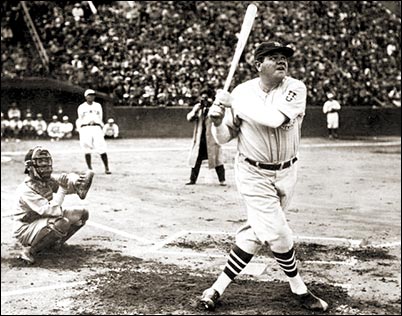 Stunned by all the negative reports coming out of their recent encounter, the All American team took this game in Yokohama more seriously. For the second consecutive day, Babe Ruth smashed two home runs while Gehrig, Foxx and Averill each added one.
Stunned by all the negative reports coming out of their recent encounter, the All American team took this game in Yokohama more seriously. For the second consecutive day, Babe Ruth smashed two home runs while Gehrig, Foxx and Averill each added one.
At long last, the Japanese bats came alive. They had plated six runs on ten hits the day before and, against tough Lefty Gomez, they cracked out eleven more, which produced four runs. For the Japanese, the highlight came in the ninth inning when catcher Toshiharu Inokawa hit the first Japanese home run of the series. It came in game number eight. Several of the Japanese players had begun to accumulate respectable batting averages against Major League level pitching. Shortstop Hisanori Karita and outfielder Mamoru Sugitaya were both just below the .300 mark. However, Jimmy Horio remained in a slump. He had participated in all eight games but was just 1 for 22 at the dish.
November 20, 1934
Shizuoka, Japan
Kusangi Stadium
Attendance: 8,000
R H E
All Nippon 0 3 1
All Americans 1 5 1
WP - Whitehill LP - Sawamura
HR - Gehrig
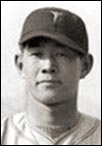 In his debut against Major League hitters, the young Sawamura had been belted hard. It was not easy to criticize a 17-year old playing against men, mature and seasoned professionals at that. In his second appearance on the knoll, a relief chore, he began to show signs of brilliance. By the time he made his third appearance, he would electrify a nation. The game was played at Kusangi Stadium in Shizuoka, 80 miles south of Yokohama. The venue was the smallest in terms of seating capacity (only 8,000) on the tour and the distances to the fences were considerably less than in either Meiji Stadium (Tokyo) or Koshien Stadium (Osaka). The scenario was primed to be a cornucopia of home runs for the power-hitting Americans.
In his debut against Major League hitters, the young Sawamura had been belted hard. It was not easy to criticize a 17-year old playing against men, mature and seasoned professionals at that. In his second appearance on the knoll, a relief chore, he began to show signs of brilliance. By the time he made his third appearance, he would electrify a nation. The game was played at Kusangi Stadium in Shizuoka, 80 miles south of Yokohama. The venue was the smallest in terms of seating capacity (only 8,000) on the tour and the distances to the fences were considerably less than in either Meiji Stadium (Tokyo) or Koshien Stadium (Osaka). The scenario was primed to be a cornucopia of home runs for the power-hitting Americans.
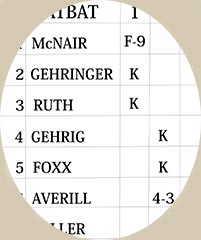 The game started routinely. The hosting Nippons, batting first, were retired in order. Eric McNair was the first All American to face Sawamura, popping out to short right-field. In assessing the American League line-up prior to the game, the one player who really concerned Sawamura was "The Mechanical Man", Charlie Gehringer, who was batting second in the order. Sawamura detected no flaws in Gehringer’s swing. Theirs was to become a spiritual battle between pitcher and hitter. Sawamura saw it as dueling samurai. To his surprise, relief and joy, he was able to strike out his worthy opponent. Two up and two down. Now strolling to the plate was the reverent Babe Ruth. More than twice the age of the young Japanese flame-thrower, the normally jovial Ruth seemed more serious than usual. In his previous game facing Sawamura, the Bambino had smashed a long home run but he also had struck out. Both players were anxious to improve their performance. Sawamura no longer saw the Major Leaguers as Gods. He was confident that, if he pitched intelligently and aggressively, he could win. Blazing a pair of fast balls by the “Babe” and then crossing him up with a floating curve ball, Sawamura rang up an impressive punch out that had Ruth spinning. Three up and three down.
The game started routinely. The hosting Nippons, batting first, were retired in order. Eric McNair was the first All American to face Sawamura, popping out to short right-field. In assessing the American League line-up prior to the game, the one player who really concerned Sawamura was "The Mechanical Man", Charlie Gehringer, who was batting second in the order. Sawamura detected no flaws in Gehringer’s swing. Theirs was to become a spiritual battle between pitcher and hitter. Sawamura saw it as dueling samurai. To his surprise, relief and joy, he was able to strike out his worthy opponent. Two up and two down. Now strolling to the plate was the reverent Babe Ruth. More than twice the age of the young Japanese flame-thrower, the normally jovial Ruth seemed more serious than usual. In his previous game facing Sawamura, the Bambino had smashed a long home run but he also had struck out. Both players were anxious to improve their performance. Sawamura no longer saw the Major Leaguers as Gods. He was confident that, if he pitched intelligently and aggressively, he could win. Blazing a pair of fast balls by the “Babe” and then crossing him up with a floating curve ball, Sawamura rang up an impressive punch out that had Ruth spinning. Three up and three down.
On the mound for the Americans was veteran Earl Whitehill who quickly retired the side in the bottom half of the frame. No one could have forecast what would unfold in the second inning. The Americans would send Lou Gehrig, Jimmie Foxx and Earl Averill to the plate. Among the three of them, they were responsible for hitting 124 home runs during the 1934 season. Incredibly, Sawamura whiffed Gehrig for his third consecutive K. Could he add the 1933 home run champion to his list? In the 1934 All-Star game, Carl Hubbell had fanned Ruth, Gehrig, Foxx, Simmons and Pinky Higgins in succession. Could a 17 year-old Japanese school boy duplicate this outstanding achievement? Down went venerable Foxx on strikes. Earl Averill, the next batter was one of the toughest outs in the American League and seldom was a strikeout victim. The battle was on and once the count reached 3 and 2, Sawamura was not confidant enough of his tricky curveball to unfurl it on a full count. Instead, he reared back and launched his bread and butter pitch, the two-seam fastball. Expecting the heater, Averill dug in and connected squarely but ended up grounding out to second.. Six up and six down, four by strikeouts.
In the top of the third, the Japanese got the first hit of the game. An error by Foxx followed which put two on with only one out but the potential rally fizzled out and the Nippons failed to score. The second time through the batting order would be more difficult for Sawamura. “Rabbit” McNair sent a sharp drive between third and short but Hisanori Karita made a brilliant defensive play and threw him out at first. Next came Gehringer. Another samurai battle and another conquest for Sawamura. "The Mechanical Man" could only muster a slow roller to second and was easily thrown out. With two retired in the fourth and the Major Leaguers still looking for their first hit, Babe Ruth sent a clean single up the middle and the no-hitter was broken. After a dozen All American batters had taken a turn at bat, the visitors finally had a base runner. Gehrig followed Ruth to the platter and got a good piece of the bat on the ball but it was directed to shortpatcher Karita and the inning was over. End of four, the score remained knotted at zero.
While the crowd was buzzing over Sawamura's performance, his mound opponent Earl Whitehill was equal to the task. He easily retired the Japanese in both the fifth and sixth innings, although he did yield a lone single to fly chaser Kumeyasu Yajima. In the bottom of the sixth panel, Sawamura ran into trouble. A walk to the opposing pitcher and a single by McNair with one-out preceded Gehringer’s third plate appearance. Sawamura enticed his spiritual and diamond opponent to fly out, preventing any advance by either runner. Babe Ruth then sauntered to the plate eager to drive in the pair of ducks on the pond. Ruth had already singled and now believed he had Sawamura figured out. For some inexplicable reason, however, with the “Babe” at the plate, pitcher Whitehill, who had not pilfered a base all season or even attempted such an act of larceny, tried to steal third and was gunned down. End of inning. End of threat. In the top of the seventh, Whitehill walked Isamu Fuma and the following batter, Minoru Yamashita, promptly sacrificed him to second. With a chance to drive in the game's first run, Shigeru Mizuhara could only only manage a short fly to right. One chance to score remained. The next batter was weak-hitting infielder Usaburo Shintomi. To date, he had collected only one safety in 14 times at bat. On the bench was Japan's leading slugger, Toshiharu Inokawa, who was hitting .333 and had his team's only home run. Also available to pinch-hit was Mamoru Sugitaya who was 7 for 24 against Major League pitching. In what had to have been of the biggest blunders, manager Miyake made the decision to leave Shintomi in the game. Big mistake. He hit a comebacker to Whitehall and was tossed out at the initial sack, a second blown scoring opportunity by the Japanese.
Leading off the last half of the seventh, the “Bambino”, who had been left standing at the plate the previous inning, now sent a routine fly ball to right-field for the initial out. Gehrig took a strike and then, waiting for Swamura's curve, sent a line drive over the right-field fence. Interestingly, had that ball been hit in either Meiji or Kosheien Stadiums, it would have been an easy out but, unfortunately for Sawamura and his countrymen, the home run counted. The final score of the game was 1 - 0 in favor of the Americans. Sawamura had held the mighty Americans to but one run on five hits yet he lost. The All Nippon nine had several scoring chances but questionable decision-making by manager Miyake contributed to their demise.
 By the next morning as the Japanese read their morning papers, a new national hero had been born. Unheralded Eiji Sawamura, a 17 year-old High School pitcher, had held the mighty All Americans hitless until the fourth round and scoreless until the seventh. With the spirit of the samurai present at his side, Sawamura had whiffed four of the first five batters he faced, four in succession, including the powerful quartet of Gehringer, Ruth, Gehrig and Foxx.
By the next morning as the Japanese read their morning papers, a new national hero had been born. Unheralded Eiji Sawamura, a 17 year-old High School pitcher, had held the mighty All Americans hitless until the fourth round and scoreless until the seventh. With the spirit of the samurai present at his side, Sawamura had whiffed four of the first five batters he faced, four in succession, including the powerful quartet of Gehringer, Ruth, Gehrig and Foxx.
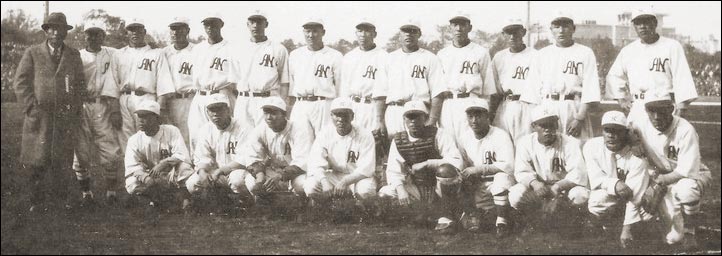
November 22, 1934
Osaka, Japan
Koshien Stadium
Attendance: 48,000
R H E
All Nippon 5 14 0
All Americans 6 15 0
WP – Cascarella LP – Date
Sawamura's pitching masterpiece gave the All Nippon a new sense of confidence as the two teams embarked upon an eight-day, six game junket of southern Japan. The one thousand mile journey included stops in Nagoya, Osaka, Kokuro and Kyoto. Nagoya was one of Japan's largest cities with a population of over one million.
The rejuvenated Japanese wasted little time scoring the game's initial counter. Kumeyasu Yajima opened with a triple and scored on a Hisanori Karita one base drive. Catcher Toshiharu Inokawa also singled for the third consecutive hit off Joe Cascarella. With runners on first and second with no outs recorded, manager Miyake committed another blunder. He ordered his clean-up batter to bunt. Minoru Yamashita laid down the perfect sacrifice bunt, advancing both runners. Karita scored on a ground-out and Shigeru Mizuhara struck out. The Japanese rally stalled at two runs, a sum that would never be enough when playing the Americans.
In the bottom of the first, two Japanese errors and three consecutive singles surged the Americans into a 3 - 2 lead. In arrears by a single tally, pitcher Masao Date pitched admirably, holding the high-scoring Americans off the scoreboard until the eighth inning. Meanwhile, the Japanese continued to connect off Cascarella and eventually took the lead again 5 – 3, courtesy of outfielder Isamu Fuma’s two RBI’s. Earl Averill opened the bottom of the eighth with a walk. Bing Miller also walked. Frank Hayes eventually singled home the fourth American run and Charlie Gehringer tripled home Miller and Hayes as the tourists took back the lead 6 - 5. Isamu Fuma tripled for the Nippons in the ninth, his fourth base knock of the fracas. With the potential tying marker 90 feet away from home and a golden opportunity to knot the count, manager Miyake again opted to let a weak batter stay in the game rather than going to his bench for a pinch-hitter. Not surprisingly, Shinji Hamazaki struck out. Even Babe Ruth was critical of Miyake's tactics.
November 23, 1934
Nagoya, Japan
Narumbi Park
Attendance: 38,000
R H E
All Nippon 2 7 1
All Americans 6 13 0
WP - Gomez LP - Takeda
The Major Leaguers took an early 4 - 0 lead behind the superb pitching of Lefty Gomez. In the sixth, Nippon chucker Kaichi Takeda drew a base on balls and Mamoru Sugitaya followed with a two-bagger, sending Takeda to third. Osamu Mihara then singled home Takeda and Isamu Fuma tripled for the second consecutive game but only Sugitaya scored as Mihara was thrown out at home on a laser toss from the relay man, Charlie Gehringer. The barnstormers added two more runs in the seventh and Gomez shut down the Japanese for the last two innings.
November 24, 1934
Osaka, Japan
Koshien Stadium
Attendance: 50,000
R H E
All Nippon 3 7 1
All Americans 15 12 0
WP - Whitehill LP - Date
Despite not having even one victory in the series, the All Nippons were greeted with their most supportive and boisterous crowd to date when more than 50,000 Osakans showed up at Koshein Stadium. Miyake continued to show questionable judgement as a field manager by nominating Masao Date to pitch with only two days rest. Date had been involved in the cliff hanger 6 – 5 loss. He started off well in this joust and held the Yanks scoreless until the fourth. An error by second basemen Osamu Mihara put Foxx on first. This seemed to unnerve Date who then walked Averill and proceeded to allow consecutive hits by Bing Miller, Frankie Hayes, pitcher Earl Whitehill and “Rabbit” McNair. Before the smoke had cleared, Date had surrendered four runs and the game was virtually over. In relief, Shinji Hamazaki fared no better, giving up six runs. Whitehill was fully in charge until the seventh when he was nicked for a triad of counters. Kenichi Aoshiba, the third Japanese chucker allowed four more tallies. To the shock and dismay of the crowd of 50,000, Aoshiba uncorked a pitch that hit the “Babe” on the ankle. it turned out not to be anything serious as the Americans triumphed easily 15 - 3
November 25, 1034
Osaka, Japan
Koshien Stadium
Attendance: 30,000
R H E
Miller's Team 5 10 0
Ruth's Team 1 5 4
WP - Brown LP - Aoshiba
HR - Shintomi
Playing their fourth game in as many days, players on both teams looked tired and listless. Commenting on the play, the Japan Weekly Chronicle referred to this Sunday match as "a dull sort of affair." It was another split squad match. In an attempt to attract more fans, another home run derby was scheduled but even this promotion failed to draw a crowd in excess of 30,000 in a facility capable of handling throngs over 100,000. Ruth's ankle recovered sufficiently but he could only muster one hit in three trips to the plate. Interestingly, the American power hitters had not homered since Lou Gehrig beat Sawamura back on November 20th. In the giant Koshien Stadium, they had failed to connect for a four-ply clout in both of their appearances there. The highlight of the game, from the standpoint of the Nipponese fans, had to be the blast unleashed by nineteen year-old local boy Usaburo Shintomi who was able to accomplish what no American slugger could do, homering at Koshien Stadium.
November 26, 1934
Kokura, Japan
Itozu Grounds
Attendance: 25,000
R H E
All Nippon 1 7 1
All Americans 8 11 1
WP - Cascarella LP - Hamazaki
HR - Ruth and Averill
Kokura was home to Japan's newest hero, Usaburo Shintomi. A packed house of 25,000 was on hand to greet Shintomi and his teammates. Unfortunately, game conditions were atrocious. Heavy rain left the playing field in unplayable condition. Normally such deplorable field conditions would be grounds for the game’s cancellation but, with a sell-out crowd in attendance, many of whom had travelled long distances to get there, meant the game had to proceed. Unfortunately, the contest itself turned out to be joke. Many American players wore rubber boots. The mud in some places was ankle deep. Notwithstanding these atrocious playing conditions, the "Sultan of Swat" socked out one of the longest home runs of the entire series. It marked the Americans’ first long ball tater in six games.
November 28, 1934
Kyoto, Japan
Attendance: 30,000
R H E
All Nippon 1 5 3
All Americans 14 14 2
WP – Gomez LP - Sawamura
HR - Miller
Kyoto was the country's cultural capital. In 1934, the city contained more than a thousand temples and shrines including some of the most spectacular buildings in Japan. The game was delayed one day due to heavy rains as no one wanted a repeat of the fiasco in Kokuro. The rain had subsided but the temperature at game time was near zero. Not the best playing conditions for baseball. However, pre-game excitement reigned supreme as the scheduled starting pitcher for the Nippons was Eiji Sawamura. The teenage starboard hurler had attended school at the Kyoto Commercial and, as the golden boy of the area, helped draw a capacity crowd to the ballpark including Prince Taka Kuni, a member of the Imperial Family. For the third time in the series, the Americans had to remove their ball caps to respect royalty. Within that culture, the imperial Family was more than just a monarchy, it was Deity.
 Unfortunately, the local hero could not repeat his previous stellar performance. The All Americans jumped out to an early 2 - 0 lead in the bottom of the first canto. They added five more in the third and another three in the fourth. Sawamura was wild and he walked seven batters. Factoring in eight hits that he yielded, this resulted in 10 runs in just four innings. In his previous start, Sawamura had baffled the Americans with a two-seam fastball and a crafty curve. Babe Ruth learned from that experience and was able to predict Sawamura's delivery this time out. According to the “Babe”, the youngster was tipping his pitches.
Unfortunately, the local hero could not repeat his previous stellar performance. The All Americans jumped out to an early 2 - 0 lead in the bottom of the first canto. They added five more in the third and another three in the fourth. Sawamura was wild and he walked seven batters. Factoring in eight hits that he yielded, this resulted in 10 runs in just four innings. In his previous start, Sawamura had baffled the Americans with a two-seam fastball and a crafty curve. Babe Ruth learned from that experience and was able to predict Sawamura's delivery this time out. According to the “Babe”, the youngster was tipping his pitches.
November 29, 1934
Omiya, Japan
Attendance: 8,000
R H E
All Nippon 5 10 3
All Americans 23 23 2
WP - Whitehill LP - Takeda
HR - Horio, Gehringer (3), Ruth (2), Whitehill (2), Gehrig, Foxx and Hayes
The ball park at Omiya was small not only in terms of seating capacity but also in the short distances to the outfield fences. These dimensions were minor league at best. Kaichi Takeda started on the hillock for the All Nippon aggregation but what began as a baseball game become batting practice for the power-slugging All Americans. In the first inning alone, the major Leaguers absolutely crushed Takeda, as they blasted home run after home run. By the end of the initial frame the score was already 10 - 0. Single tallies were plated in the third, fourth and fifth innings to bring the score to 13 - 1. With such a huge lead, Earl Whitaker, who would homer twice himself, eased up in the sixth and served up a fat pitch to Jimmy Horio who was experiencing a frustrating series. Although the Japanese-American diamondeer connected for a three run homer, it was a case of much too little, much too late. With the score sitting at 23 – 5, Daisuke Miyake brought in 18 year-old Russian born pitcher Victor Starffin who proceeded to walk both Gehrig and Averill. He then struck out Jimmie Foxx and enticed Bing Miller to hit into a double play. For some inexplicable rationale, it would be the only inning that the solidly-built Starffin would pitch in the entire series. Was this just another example of managerial incompetence or was it racism on the part of Miyake?
December 01, 1934
Utsunomiya, Japan
Attendance: 12,000
R H E
All Nippon 5 7 3
All Americans 14 11 3
WP - Brown LP - Sawamura
HR - Miller (2), Gehringer and Averill
Utsunomiya is a small city 60 miles north of Tokyo and was the final game played by the All Americans on Japanese soil. Babe Ruth invited series organizer Sotaro Suzuki to "manage" the American team. Sotaro knew this challenge would not be easy. The Americans had won every game so far but Sotaro knew that many of the Americans were homesick and tired. Would they let down? In addition, the All Nippons would be starting Eiji Sawamura on the knoll, providing the youngster one more opportunity to duplicate his November 20 masterpiece. Playing conditions were once again deplorable. With the temperature plummeting, charcoal heaters were set up in each dugout.
A walk and a rare error by Earl Averill followed by three consecutive hits off the bats of Usaburo Shintomi, Tokio Tominaga and Hisashi Akakuro produced three counters and an All Nippon 3 – 0 lead. In an effort not to "tip" his pitches, Sawamura overreacted and ran into control problems. On November 20, Sawamura had begun the game striking out four of the first five batters he faced. Not today. He walked the first four batters he faced and only a double play enabled him to escape the first inning yielding but one run. Regrettably for the Nippon nine and their supporters, Sawamura just did not have it on this occasion. By the time that Kenichi Aoshiba replaced him in the fourth inning, the youngster had surrendered 9 runs and an eye-popping 9 walks. Meanwhile Clint Brown scattered seven hits on the way to a 14 - 5 victory.
After the game, the hosts gave awards to the statistical leaders. Babe Ruth finished first in most categories. He batted .408, hit 13 homers, drove in 33 runs and scored 27 himself. Earl Averill finished second in almost every offensive classification. Lefty Gomez compiled a 5 - 0 record, a 1.47 ERA and whiffed 34 batters, yet another portsider known as "The Earl", Earl Whitehill, was even better. He went 6 - 0, with a 1.47 ERA and walked 12 fewer batters. In addition, he was also impressive at the plate, batting .458 with eleven hits including three home runs. Joe Cascarella was the strikeout king with 49. Eric McNair had the most doubles (9) and was runner-up to Babe Ruth in hits with 29. The Americans batted .326 as a team. Despite their overall poor performance, many Japanese players hit Major League pitching well. Catcher Toshiharu Inokawa led his team with a .345 batting average and a home run. Kumeyasu Yajima and Isamu Fuma both finished just under .300. Outstanding shortstop, Hisanori Karita hit a respectable .276. Eiji Sawamura ended up with a 7.58 ERA, lost four games while striking out 35 and walking an equal number.
As noted earlier, the American team was considered the home team in every game. This meant they never had to bat in the bottom of the ninth inning. Not counting split squad contests, this meant that the Americans had 54 fewer outs than their Japanese hosts who they outscored by a hefty 123 – 23 margin. Had they batted during an additional inning, one can only imagine how many more runs they would have scored.
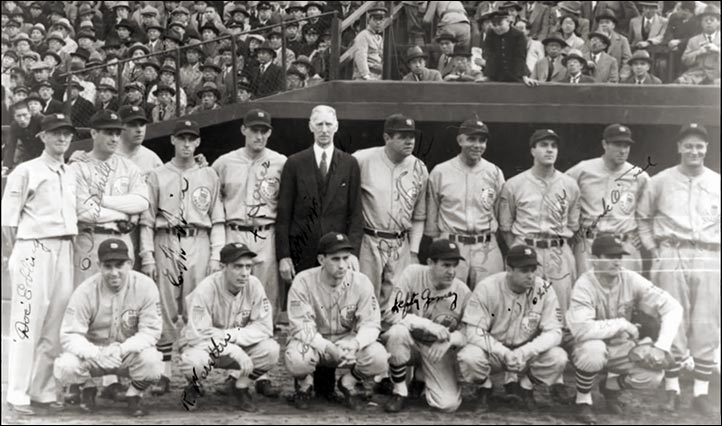
December 05, 1934
Shanghai, China
Attendance
R H E
All Americans 22 19 xx
Chinese All Stars 1 7 xx
WP - Cascarella LP - Morris
Wrapped up like Eskimos, America's touring baseball players carried their Far Eastern march into China with a 22 - 1 crushing defeat of the Shanghai All Stars. After grounding out three times, Babe Ruth complained, "I'm wearing four shirts and underwear but I am still cold.” Had the Americans not travelled so far, this game would never had been played.
Corporal H. L. "Lefty" Morris, a Marine from Alabama, was the starting hurler for the Chinese squad and had a day for the scrapbook fanning Rabbit Warstler, Charlie Gehringer and Eric McNair in the first inning and getting Ruth in the fifth. Morris held the tourists to two hits and two unearned runs over the first four innings before falling apart in the fifth giving up seven hits and nine runs before being sent to the showers. The Shanghai nine was composed of players from the Marine Corps and Japanese civilians.
December 09, 1934
Manila, Philippines
Rizai Memorial Stadium
Attendance: 15,000
Game #1 R H E
All Americans 13 xx xx
Manila Bay Leaguers 1 xx xx
WP - Whitehill LP - Nelson
HR - Ruth and Gehrig
Game #2 R H E
All Americans 7 11 2
Philippine Olympic National team 3 7 1
WP - Gomez LP - Armando
HR - Averill (2) and Gehrig
Once again Babe Ruth was the star attraction. Newspapers had tracked his team's progress across Asia, whipping interest into a frenzy. The ball park in Manila was larger than most and the foul poles were deep, stretching to over 350 feet from home plate. It reminded many of old Comiskey Park with its 350 foot foul lines. The field dimensions never came into play. During batting practice, the “Babe” was easily clearing the fences. These practice clouts were a harbinger of what was to unfold during the opening game of the twin-bill. Frankie Hayes hit a two-run triple to stake the Yanks to a third-inning lead. Gehrig unloaded a three-run round-tripper in the sixth and the Babe delivered the coup de grace with a towering four-ply blast in the seventh. For the locals, the hero of the day was Charlie Erdman, director of the Manila Y.M.C.A., who pitched five innings, striking out Ruth on a called strike, fanning Foxx and hitting a double.
The follow-up tilt was expected to be a tougher assignment. Whereas the Manila Bay Leaguers were drawn from local teams, the Olympic All Stars were comprised of the best players in the Philippines. This contest attracted a full house. The score was close but, once again, the Americans prevailed. Lefty Gomez took care of the pitching, holding the Olympics to three runs while Earl Averill, with a brace of dingers, and Lou Gehrig looked after the hitting with home runs. Averill's second blast was an awesome drive over the center field wall.
December 10, 1934
Manila, Philippines
Attendance: N/A
R H E
All Americans 9 13 1
Philippine Olympic National Team 1 4 0
WP - Brown LP - Bautista
HR - Gehrig
Despite favorable praise from Connie Mack as to the calibre of Philippine baseball, the last game was a blowout. The Americans shelled Bautista for 13 hits and nine runs, ending their tour as they began it with a decisive victory. They played 23 games and won them all. Gehrig hit the final game’s lone home run. Generously, the Americans deliberately allowed a run in the bottom of the ninth to avoid shutting out their hosts.
CODA
Total gate receipts for the 18 games in Japan exceeded $100,000. This was a substantial amount back in 1934. It is believed that the Bambino's share of these proceeds was approximately 20 per cent. One would have to concur that he earned and deserved it. At the age of 39 and never to don a New York Yankee uniform again, he played in every game, spanking the sphere at a .408 clip while slugging 13 home runs. He was an idol, celebrity and an impressive goodwill ambassador. Everywhere he went, he was greeted with cries of "Banzai Babe". There was not one improper incident throughout the entire trip. Kids and grownups heaped attention, gifts, and acclaim on him and stood at times for hours to purchase tickets just to see the “Babe”.
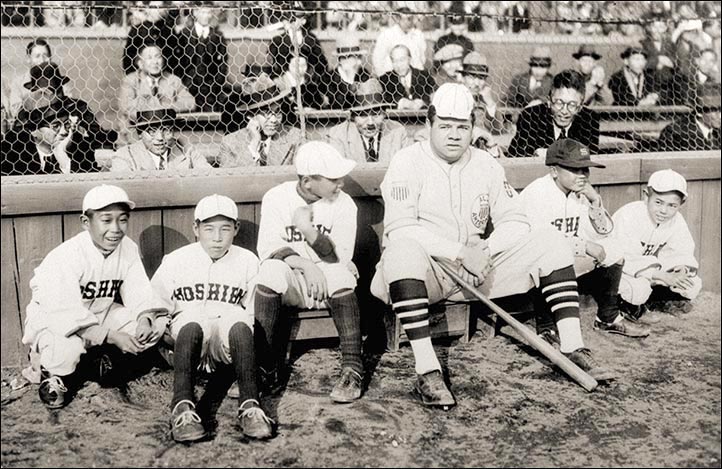
The 1934 tour was an economic success. The impending war undermined any cultural value but the Japanese never forgot the “Babe”. He is remembered in their Baseball Hall of Fame in Tokyo. There is also a shrine dedicated to him in Sendai, northeast of Tokyo. The shrine is located at the exact spot where the Ruth belted his first home run in Japan. The stadium is long gone, but the memory of the “Sultan of Swat” remains. The tour would be the last of its kind until after the war. Big League Club owners worried about injuries. Gehrig had been hit on the 1931 tour and both Foxx and Ruth were hit in 1934. In 1951, an old friend, Lefty O'Doul, brought over an all-star squad that won 13 out of 14 games. At this juncture, the Americans had brought their overall record against Japanese teams to an astonishing 100 - 2. Equality did not come until 1966. The Los Angeles Dodgers were that year's National League champions yet found the Japanese All Stars a difficult opponent, dropping eight games to the Nippons while playing to a tie in another. Baseball fans in both the United States and Japan began talking about a real "World Series.” Every baseball fan knows the “Babe” would have liked that.
AMERICAN LEAGUE ALL-STARS TOUR OF WESTERN CANADA 1934 GAME REPORTS
AMERICAN LEAGUE ALL-STARS TOUR OF JAPAN 1934 GAME REPORTS
TOYKO GIANTS BARNSTORMING TOUR OF WESTERN CANADA 1935 GAME REPORTS



